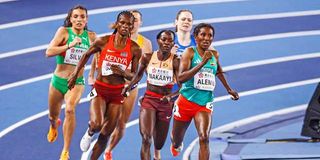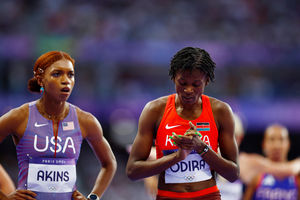
Portugal’s Patricia Silva, Kenya’s Lilian Odira, Uganda’s Halimah Nakaayi and Ethiopia’s Habitam Alemu race in the women’s 800 m - heat one of the World Athletics Indoor Championships at Nanjing Youth Olympic Sports Park, Nanjing, China .
Kenya yesterday wrapped up its campaign at the 2025 World Athletics Indoor Championships in Nanjing, China without a medal.
US-based Susan Ejore—competing in the last event for the country—finished fifth in the women’s 1,500m final. Ejore clocked 4:03.89 in a race won by Ethiopia’s Gudaf Tsegay, who set a course record of 3:54.86.
Her compatriot Diribe Welteji took silver in 3:59.30, while Georgia Hunter Bell secured bronze in 3:59.84.
The disappointing outing at the three-day championship further highlighted Kenya’s long-standing struggles in indoor competitions, largely attributed to the absence of an indoor athletics facility in the country.
At the 2024 edition, Kenya managed just one medal—Beatrice Chepkoech’s bronze in the 3,000m—finishing 13th overall in the rankings. Historically, Kenya has collected a total of 42 medals (10 gold, 15 silver, and 17 bronze) at the World Indoor Championships.
Bernard Ouma, founder and CEO of Rongai Athletics Club and a seasoned coach, explained that Kenya’s struggles stem from both climatic conditions and inadequate infrastructure.
“The championships take place at the tail end of winter, and indoor facilities play a crucial role in performance,” Ouma said.
“Western countries have many indoor training facilities, and during winter, their athletes train in these stadiums. That gives them a huge advantage over our athletes, who are more accustomed to outdoor competition.”
Ouma, an alumnus of the Hungarian University of Sports Science in Budapest, Hungary, added that the few Kenyan athletes selected for the championships likely had little exposure to indoor racing before the event.
“The surface in indoor facilities is different—less firm than outdoor tracks—leading to more pushing and jostling. Senior athletes sometimes avoid these races to prevent injuries. It’s an unfamiliar environment for our athletes, so this shouldn’t be seen as an indicator of their overall season performance,” Ouma added.
On Saturday, eight of the nine Kenyan athletes bowed out without winning a medal.
Lilian Odira, who had high hopes of reaching the 800m final, tripped and fell in her heat, finishing sixth in 2:16.12. In the men’s 800m, Noah Kibet (1:48.90) and Alex Ngeno Kipngetich (1:47.53) both finished fourth in their respective heats, failing to advance to the final.
In the women’s 3,000m final, Purity Kajuju Gitonga finished eighth in 8:44.56. The race was won by Ethiopia’s Freweyni Hailu in 8:37.21, followed by USA’s Shelby Houlihan (8:38.26) and Australia’s Jessica Hull (8:38.28). Cornelius Kemboi finished eighth in the men’s 3,000m, clocking a personal best of 7:49.00.
Norway’s Jakob Ingebrigtsen won gold with a season’s best of 7:46.09, edging out Ethiopia’s Berihu Aregawi (7:46.25) and Australia’s Ky Robinson (7:47.09).
Athletics Kenya President Jack Tuwei acknowledged that the team selection process for indoor championships is often limited, primarily based on global rankings and athlete willingness.
“Indoor events have fewer competitors, and all countries send lean teams. We rely on the world ranking system for selection because we do not hold trials due to the lack of an indoor facility in Kenya,” Tuwei said in an earlier interview.






